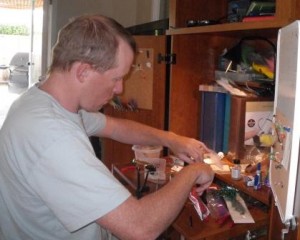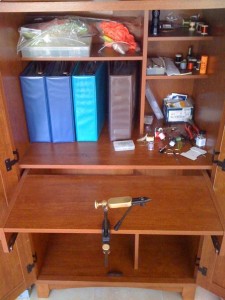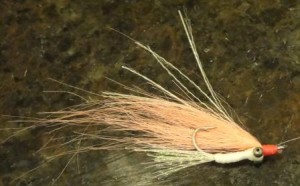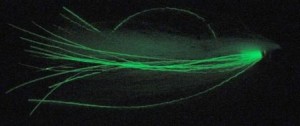This blog has always been about the arc of discovery, the journey to learn more about bonefish and the places and people that relate to them. I quickly discovered the Flatswalker blog and read about the author’s experiences as he learned the bonefish game in his native Grand Caymans. Davin Ebanks writes Flatswalker and has a guide service in Grand Cayman called Fish Bones.
I put some questions to Davin about bonefishing and Grand Cayman and this is Part I of that interview.

Davin with a happy client in Grand Cayman
Q. Grand Cayman got hit pretty hard by Hurricane Ivan back in 2004. Were you there at the time? Has the Island recovered?
A. Grand Cayman got hit the hardest of our three islands, but I was (luckily) not there at the time. I’d left a week prior on personal business to Jacksonville, FLA and at that time the storm was predicted to hit Haiti or Cuba, not Cayman. They were wrong. I was in contact with family as early as the next night, but was unable to get back home for about a month! There was such a limit on basic supplies (like water, food, sleeping space, etc.) that it just didn’t make sense to add to the burden. There wasn’t even power available to start making repairs or cleanup for about 2-3 weeks. So, I stayed in Florida and went fishing for a month.
When I got back I was very relieved to see that though there were thousands of fish killed by the storm surge, bonefish were not among them. More importantly, the flats were almost exactly the same as I’d left them – same holes, same drop-offs, a few more rocks and random debris but that’s about it. Given the state of the shoreline (which looked like someone had used it for bombing practice and then sprayed it with a few thousand tons of Agent Orange for good measure), I couldn’t believe something as soft as turtle grass could survive. But it did.
Luckily, the island has mostly recovered since then. In fact, there are only a few places where you can even see signs of the devastation. There are a few houses still derelict and some dead mangrove stumps along the coast, that’s about it. The biggest change is in the inhabitants’ hurricane readiness. We watch the Weather Chanel like hawks and board up our windows pretty much as soon as a major storm leaves the coast of Africa… and we leave them boarded up till mid-December when Hurricane Season is good and over.
Q. What about Grand Cayman sets it apart from its Caribbean neighbors?
A. Well, to start with we don’t have very many neighbors, unlike the eastern Caribbean islands. There’s Cuba and Jamaica, that’s about it. Also, even though we’ve just celebrated our quincentennial, we’ve been only sparsely inhabited for most of that time. That means that unlike Jamaica (to pick a random country) our water’s have not been fished into a marine desert. (That’s not to say there’s no fish in Jamaica, but in those areas where there’s access the subsistence lifestyle of the citizens means almost anything edible has been fished and fished heavily.) Also, there’s a distinct lack of crime in Cayman. There are the occasion petty thefts, but by and large you can explore the shoreline with impunity.
However, I’d say the biggest difference is the ease of access to our flats. Being a mountain peak more or less isolated in the Caribbean basin, our flats are almost all Oceanside flats… which are firm and wadeable. We certainly don’t have the expansive flats of the Bahamas, but the common site of tailing bonefish begins to make up for that. (And I mean hard-core, third of their bodies out the water, face in the grass, tailing.) It would take too long to go into it here, but bonefish over hard-packed sand just don’t tail that consistently, not like they do over softer grassy bottoms. (e.g. The Florida Keys, Belize Oceanside, etcetera.) Casting to tailing fish in shallow water is pretty much the premier experience of the sport.
Q. What does a good day of fishing look like for you as a guide?
A. Ok, from a guide’s point of view, or simply the fishing? I guess I’ll just answer that as myself: for me a good day begins not with the most experienced client in the world, or even a great caster, but someone who will listen and (more importantly) keep fishing. Then all you really need is fish that are biting. You can deal with the weather, weird tides, cloudy skies, and all the rest, but if you have someone who just wants to catch a pile of fish, or fish that simply aren’t biting, the day is pretty much shot. I mean, we all want to catch fish, right? But, the thing about fly fishing is that it’s about the experience of fishing. I need my guests to be right there in the moment, not worried about catching fish, thinking about all the fish they caught that one time in the Abacos, or wishing the wind would blow lighter. Given a client who’s simply there to have a good time fishing, we’ll have a good day… and probably catch fish too.
If you wanted to break the thing down to basic numbers, the best day I can remember was at least 13 bonefish, a snook, and a couple baby tarpon jumped. As for the absolute best day all round: that was guiding my good buddy to his first permit on fly. Priceless.

Permit... a bonus
Q. Do you have a favorite fly?
A. Easy. The Usual. Hands down… if you’re not familiar, I’m not surprised. It’s a fly I developed specifically for smart fish on shallow, grassy flats. Check out the recipe here: http://www.fish-bones.com/flies.html#usual. It lands quietly, sinks fast, and has a lot of presence and life in the water.

The Usual
Q. Do you think the fly is really the secret or is it the confidence you have in the fly that makes it work?
A. You know, both. I think they feed each other. I had some confidence before this fly, but after a few fantastic days with it, now I simply believe. To be fair, though, I changed the way I was fishing when I began using that fly. That often happens; looking at the way a fly moves underwater can lead you to fish it differently than others, and the results can go either way. This time it was as close to magic as I’ve seen.
Check in tomorrow for Part II of my interview with Davin Ebanks, author of Flatswalker.com and owner of Fish Bones guide service/fly shop in Grand Cayman.


















